 I don't generally post informal group photos like this. But this is not your average group of people. These folks are the participants in the Watertown, SD, Worldwide Photo Walk, which happened this morning.I was worried about our weather, since October can bring cold, blustery conditions. But it was a great morning to be wandering around Uptown Watertown. And I had a great time. I hope the participants did, too.
I don't generally post informal group photos like this. But this is not your average group of people. These folks are the participants in the Watertown, SD, Worldwide Photo Walk, which happened this morning.I was worried about our weather, since October can bring cold, blustery conditions. But it was a great morning to be wandering around Uptown Watertown. And I had a great time. I hope the participants did, too.
Photography
10-02-12 Standing Out
 By the end of the day yesterday, our driveway was covered in leaves from the two ash trees in our front yard. I had run some errands around town last evening and returned just as the sun was going out of view between our neighbors' houses across the street. I turned back to look at the non-descript jumble of leaves on the driveway and noticed a patch of sunshine lighting up a very small area.I got my camera, which still had the 50mm 1.2 lens attached from yesterday's table shoot, and looked for a suitable subject for the ray of light. Knowing that I had only a minute or two, I quickly found a single, yellow maple leaf. I knew that if I arranged it just right, the gentle backlighting of the setting sun might bring it to life.And it did. You might think that I did something in software to enhance this photo. But aside from a few minor tweaks, the color and contrast you see here are what the camera recorded. Critics might suggest that the leaf is not properly focused, and I guess I would agree. But I think that the shallow depth of field and soft, unfocused parts of the yellow leaf lend to a feeling of decadence.This photo is yet another example of the importance of being in the right place at the right instant. But it is also an example of what it means to be a photographer: seeing things that others might not otherwise see. A child might lie prone to study a single leaf. And so would some photographers.
By the end of the day yesterday, our driveway was covered in leaves from the two ash trees in our front yard. I had run some errands around town last evening and returned just as the sun was going out of view between our neighbors' houses across the street. I turned back to look at the non-descript jumble of leaves on the driveway and noticed a patch of sunshine lighting up a very small area.I got my camera, which still had the 50mm 1.2 lens attached from yesterday's table shoot, and looked for a suitable subject for the ray of light. Knowing that I had only a minute or two, I quickly found a single, yellow maple leaf. I knew that if I arranged it just right, the gentle backlighting of the setting sun might bring it to life.And it did. You might think that I did something in software to enhance this photo. But aside from a few minor tweaks, the color and contrast you see here are what the camera recorded. Critics might suggest that the leaf is not properly focused, and I guess I would agree. But I think that the shallow depth of field and soft, unfocused parts of the yellow leaf lend to a feeling of decadence.This photo is yet another example of the importance of being in the right place at the right instant. But it is also an example of what it means to be a photographer: seeing things that others might not otherwise see. A child might lie prone to study a single leaf. And so would some photographers.
09-23-12 Early Morning Blur
Yes, I am driving and taking photos at the same time. But it was only 6am or so and rush hour hadn't started yet on highway 212 in Watertown, SD, where I live. Furthermore, I had my camera mounted on a tripod and I was using a cable release. So I was not a distracted driver.This is a good example of trying to fix a fairly poor photo with fancy filters. Thanks, Nik Color Efex 4.0Canon 5DIII 1s f/16.0 ISO100 50mm
09-13-12 Sitting On A Park Bench
 I was at a local park with my photo/media students recently (it's a tough job. . . ) and when they wandered off to do their thing, I took my camera out and started to take photos of the same, old things: leaves, trees, tree bark, etc. Then I saw a green, metal park bench and I knew I had found the perfect subject.I liked the color, of course, but I really liked the texture. I took several photos with a wide aperture because I liked the way metal bench looked as it gradually went out of focus in the frame. Finally, I decided the bench wasn't enough and so I put a single, worn pine cone on the bench. And here's the result.Looking for meaning and symbolism? Loneliness? Promise? E pluribus unum? Who knows what I was thinking. . . .(Incidentally, I would be impressed with anyone who saw the title of this post and thought of Jethro Tull's "Aqualung" album from the 1971. Play Me)
I was at a local park with my photo/media students recently (it's a tough job. . . ) and when they wandered off to do their thing, I took my camera out and started to take photos of the same, old things: leaves, trees, tree bark, etc. Then I saw a green, metal park bench and I knew I had found the perfect subject.I liked the color, of course, but I really liked the texture. I took several photos with a wide aperture because I liked the way metal bench looked as it gradually went out of focus in the frame. Finally, I decided the bench wasn't enough and so I put a single, worn pine cone on the bench. And here's the result.Looking for meaning and symbolism? Loneliness? Promise? E pluribus unum? Who knows what I was thinking. . . .(Incidentally, I would be impressed with anyone who saw the title of this post and thought of Jethro Tull's "Aqualung" album from the 1971. Play Me)
09-12-12 Join Me For A Photo Walk
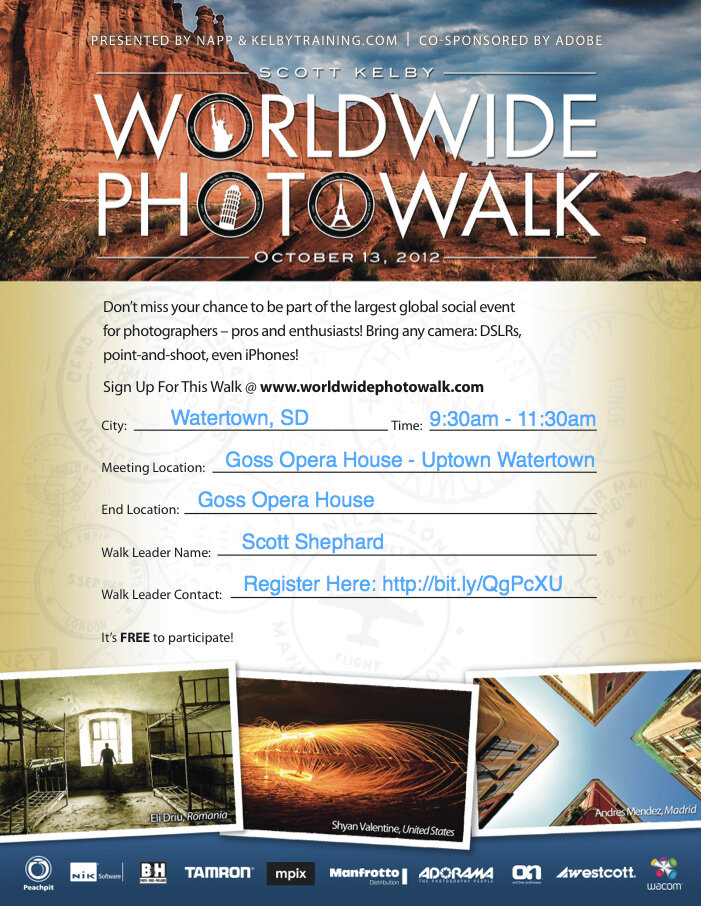 17,392 people have signed up to be part of the 5th annual Worldwide Photo Walk. Why not be 17,393? This is the first such photo walk in Watertown and I'll be your leader. What is a photo walk, you ask? Well, photography enthusiasts, from pros to little children meet and are lead to various photogenic sites by someone who is also a photography enthusiast (me).Our goal is to take some photos, have some fun and learn a little. And there are prizes for the best photos from around the world. Check out the Photo Walk web site.Then go to the Watertown Worldwide Photo Walk site and sign up. It's free and painless!
17,392 people have signed up to be part of the 5th annual Worldwide Photo Walk. Why not be 17,393? This is the first such photo walk in Watertown and I'll be your leader. What is a photo walk, you ask? Well, photography enthusiasts, from pros to little children meet and are lead to various photogenic sites by someone who is also a photography enthusiast (me).Our goal is to take some photos, have some fun and learn a little. And there are prizes for the best photos from around the world. Check out the Photo Walk web site.Then go to the Watertown Worldwide Photo Walk site and sign up. It's free and painless!
09-03-12 25,600
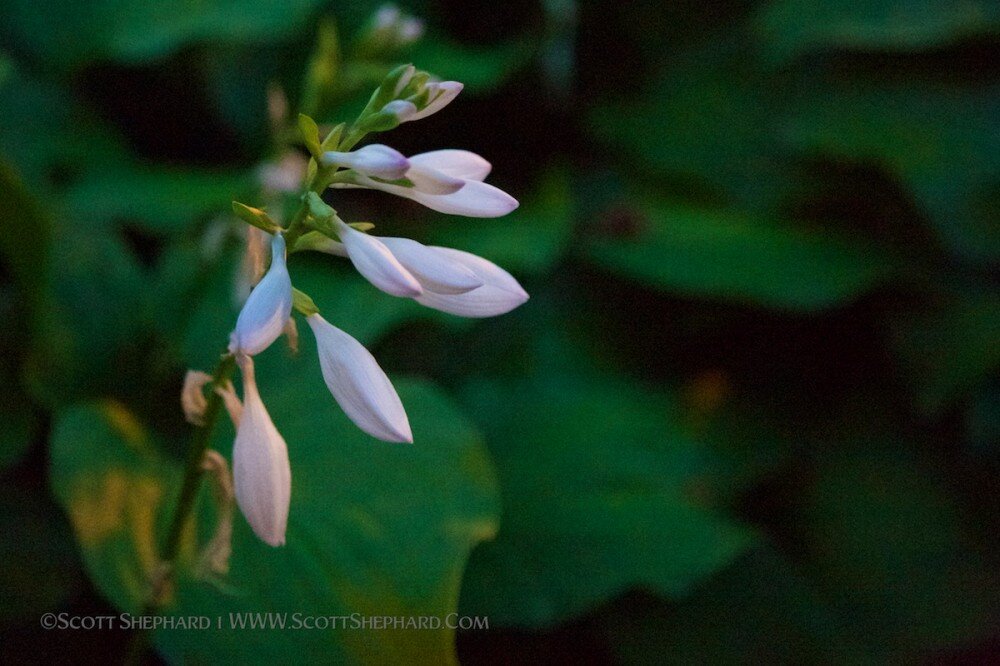 This photo is ugly in many ways. It lacks contrast, it's subject is less than perfect and it is more than a little grainy. But consider this: it was shot with my Canon 5D III at its highest "normal"* ISO setting of 25,600. It was so dark where I took this, I couldn't read the writings on the buttons on the camera. I grew up in a photographic world where 400 was considered a "high speed" film. The 5D III's sensor is 64 times more sensitive than that!When I bought my Canon 5D several years ago, I told my wife that I would never need another digital camera. It was a beautiful, high resolution camera. But then I learned that one thing that improves with each upgrade of the DSLR is it's ability to take better and better photos in lower and lower light. So when the 5D II was released, you know what happened. And now I have the 5D III, which is a beautiful high resolution camera. Maybe this one is the last camera I'll ever need?*There is an extended setting that allows for 102,400 ISO, but I'm not brave enough to try that.Canon 5D III 1/13s f/4.0 ISO25600 102mm
This photo is ugly in many ways. It lacks contrast, it's subject is less than perfect and it is more than a little grainy. But consider this: it was shot with my Canon 5D III at its highest "normal"* ISO setting of 25,600. It was so dark where I took this, I couldn't read the writings on the buttons on the camera. I grew up in a photographic world where 400 was considered a "high speed" film. The 5D III's sensor is 64 times more sensitive than that!When I bought my Canon 5D several years ago, I told my wife that I would never need another digital camera. It was a beautiful, high resolution camera. But then I learned that one thing that improves with each upgrade of the DSLR is it's ability to take better and better photos in lower and lower light. So when the 5D II was released, you know what happened. And now I have the 5D III, which is a beautiful high resolution camera. Maybe this one is the last camera I'll ever need?*There is an extended setting that allows for 102,400 ISO, but I'm not brave enough to try that.Canon 5D III 1/13s f/4.0 ISO25600 102mm
08-28-12 The Art of Seeing
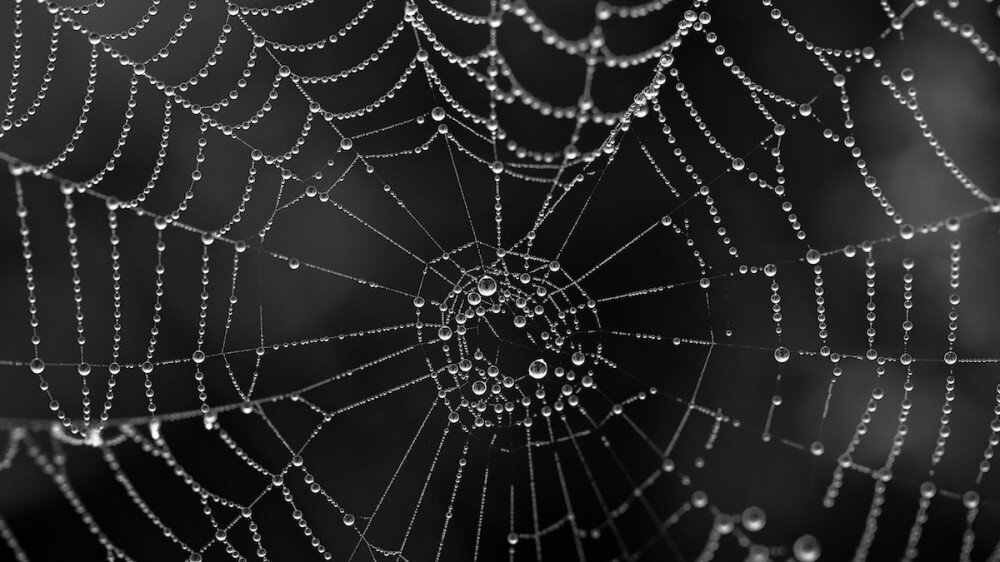 So here's a variation on my themes from yesterday: spider webs and seeing. And here's a quote that every photographer should keep in mind:
So here's a variation on my themes from yesterday: spider webs and seeing. And here's a quote that every photographer should keep in mind:
"Vision is the art of seeing what is invisible to others."Jonathan Swift
Canon 5DIII 1/160s f/4.0 ISO200 100mm
08-26-12 Golden (As seen at the Arrow Education Foundation Fund Raiser)
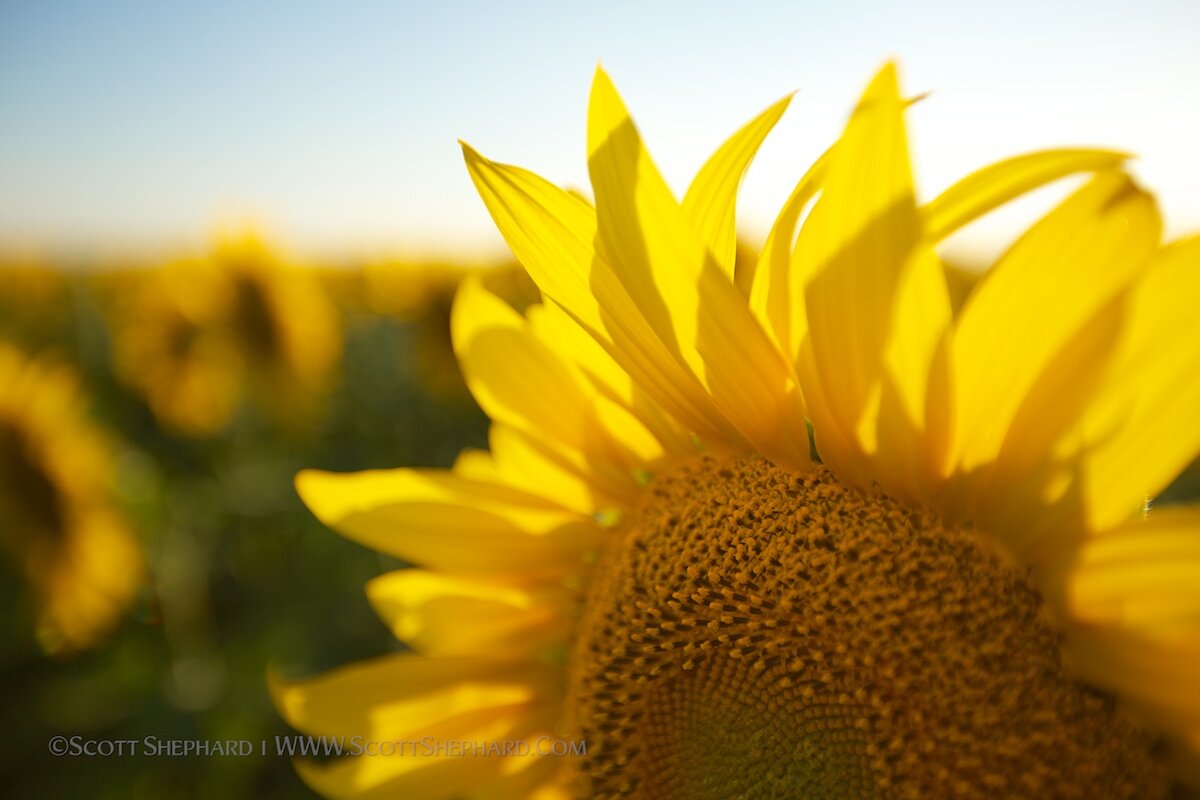 I'm no expert on sunflowers but it seems to me that they go from coming out of the ground to full flower in a fairly short time. And, sadly, they go from full flower to drooping to done in a short time, too.This field is east of Pierre, which doesn't narrow things down much since there are several sunflower fields east of Pierre. We were heading to Lake Oahe, Deb was driving and, after watching several fields go by my window, I said, "Stop. I've got to take some photos."The challenge with photographing sunflowers is something like the challenge of photographing a public building such as the Berlin Hauptbahnhof mentioned yesterday: how do you get a unique picture of something that so many others have photographed? (I just did a Google search for "sunflower pictures" and got 19,000,000 hits!).For better or for worse, this photo is my attempt at something a little different.Canon 5DIII 1/2000s f/2.8 ISO100 35mm[maxbutton id="8"]
I'm no expert on sunflowers but it seems to me that they go from coming out of the ground to full flower in a fairly short time. And, sadly, they go from full flower to drooping to done in a short time, too.This field is east of Pierre, which doesn't narrow things down much since there are several sunflower fields east of Pierre. We were heading to Lake Oahe, Deb was driving and, after watching several fields go by my window, I said, "Stop. I've got to take some photos."The challenge with photographing sunflowers is something like the challenge of photographing a public building such as the Berlin Hauptbahnhof mentioned yesterday: how do you get a unique picture of something that so many others have photographed? (I just did a Google search for "sunflower pictures" and got 19,000,000 hits!).For better or for worse, this photo is my attempt at something a little different.Canon 5DIII 1/2000s f/2.8 ISO100 35mm[maxbutton id="8"]
08-20-12 Glamorous Grain
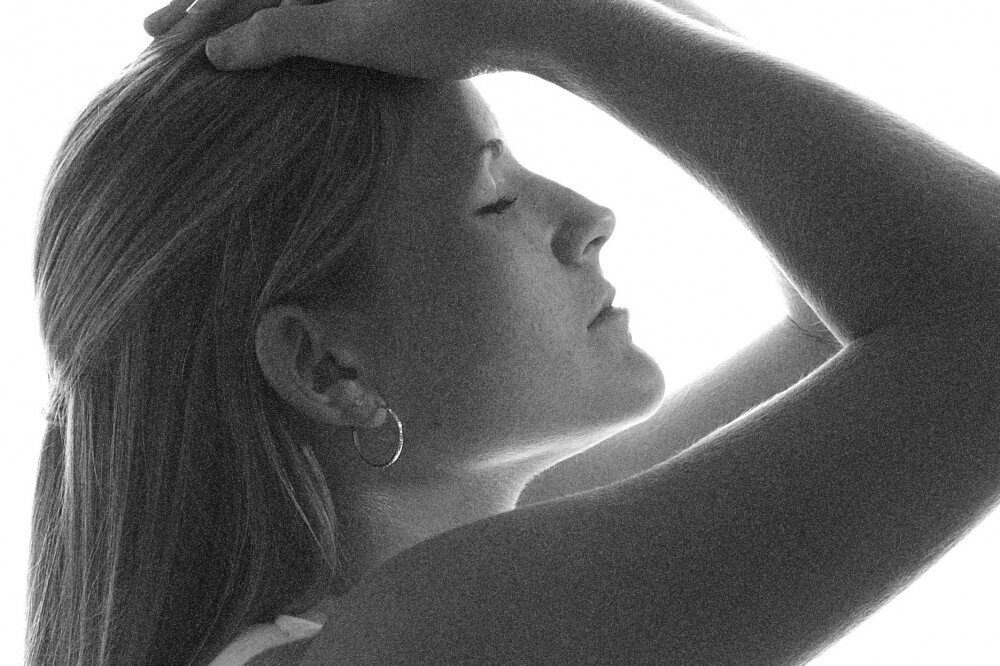 Some of you remember Tri-X Pan black and white film. It was made by Kodak and was a standard "high speed" film with an ISO of 400. That meant that you could shoot in relatively low light with this film. The down side was that you got quite a bit of grain.I can remember that when digital DSLRs hit the market, some photographers bemoaned the fact that digital photos were so smooth - there was no grain. That prompted software companies to make filters that added grain. It was an artistic effect but it also soothed the jangled nerves of photographers who were raised on film.I never missed grain, though I did play with the filters in software from time to time. This photo is evidence of that. It was shot with my 1D II, a camera that led the market at the time and which produced pretty smooth photos at ISO 100, which is what this studio photo was shot with.It occurs to me as I head back into the classroom tomorrow to meet a new group of photography candidates that much of what I've talked about in this post will be foreign to them. But so are phones with cords and movies on cassette tapes. The times, they are a changing, as Dylan says. Or was that Ecclesiastes?Canon 1DII 1/250s f/8.0 ISO100 40mm
Some of you remember Tri-X Pan black and white film. It was made by Kodak and was a standard "high speed" film with an ISO of 400. That meant that you could shoot in relatively low light with this film. The down side was that you got quite a bit of grain.I can remember that when digital DSLRs hit the market, some photographers bemoaned the fact that digital photos were so smooth - there was no grain. That prompted software companies to make filters that added grain. It was an artistic effect but it also soothed the jangled nerves of photographers who were raised on film.I never missed grain, though I did play with the filters in software from time to time. This photo is evidence of that. It was shot with my 1D II, a camera that led the market at the time and which produced pretty smooth photos at ISO 100, which is what this studio photo was shot with.It occurs to me as I head back into the classroom tomorrow to meet a new group of photography candidates that much of what I've talked about in this post will be foreign to them. But so are phones with cords and movies on cassette tapes. The times, they are a changing, as Dylan says. Or was that Ecclesiastes?Canon 1DII 1/250s f/8.0 ISO100 40mm
08-17-12 What Do You See?
 I don't know about you, but I have never looked closely at a human eye before I edited this photo. The eye you're looking at belongs to Tiffany, one of my Photo/Media students at Lake Area Technical Institute, and she was a good sport when I spontaneously told her I wanted to photograph her eyes. We went up to an area in our school that has great northern light and I took several photos.I'm not sure if a viewer would find this photo fascinating or a bit unsettling. If it's unsettling, I can tell you that it shouldn't be because Tiffany wouldn't unsettle you: she is a beautiful person, with a beautiful personality. And she has beautiful eyes.Sorry for the deep thoughts here but I think close-ups of body parts, like a single human eye, are striking because we don't tend to look so closely at them. In fact, if someone stares at us too long, we often look away. Further, an eye is in the realm of people like optometrists, not teachers, friends and acquaintances. And beyond that, it is only part of a whole that we call our bodies. I believe we are less our bodies than we are our experiences. Our bodies are like suitcases (Samsonite? Luis Vuitton?) in to which we pack our true selves.That aside, today I am showing you Tiffany's eye and asking you "What do you see?" In my case, to quote the famous discoverer Howard Carter, I see "wonderful things". . . .Canon 5DII 1/60s f/4.0 ISO200 100mm
I don't know about you, but I have never looked closely at a human eye before I edited this photo. The eye you're looking at belongs to Tiffany, one of my Photo/Media students at Lake Area Technical Institute, and she was a good sport when I spontaneously told her I wanted to photograph her eyes. We went up to an area in our school that has great northern light and I took several photos.I'm not sure if a viewer would find this photo fascinating or a bit unsettling. If it's unsettling, I can tell you that it shouldn't be because Tiffany wouldn't unsettle you: she is a beautiful person, with a beautiful personality. And she has beautiful eyes.Sorry for the deep thoughts here but I think close-ups of body parts, like a single human eye, are striking because we don't tend to look so closely at them. In fact, if someone stares at us too long, we often look away. Further, an eye is in the realm of people like optometrists, not teachers, friends and acquaintances. And beyond that, it is only part of a whole that we call our bodies. I believe we are less our bodies than we are our experiences. Our bodies are like suitcases (Samsonite? Luis Vuitton?) in to which we pack our true selves.That aside, today I am showing you Tiffany's eye and asking you "What do you see?" In my case, to quote the famous discoverer Howard Carter, I see "wonderful things". . . .Canon 5DII 1/60s f/4.0 ISO200 100mm
08-14-12 Hand County, South Dakota
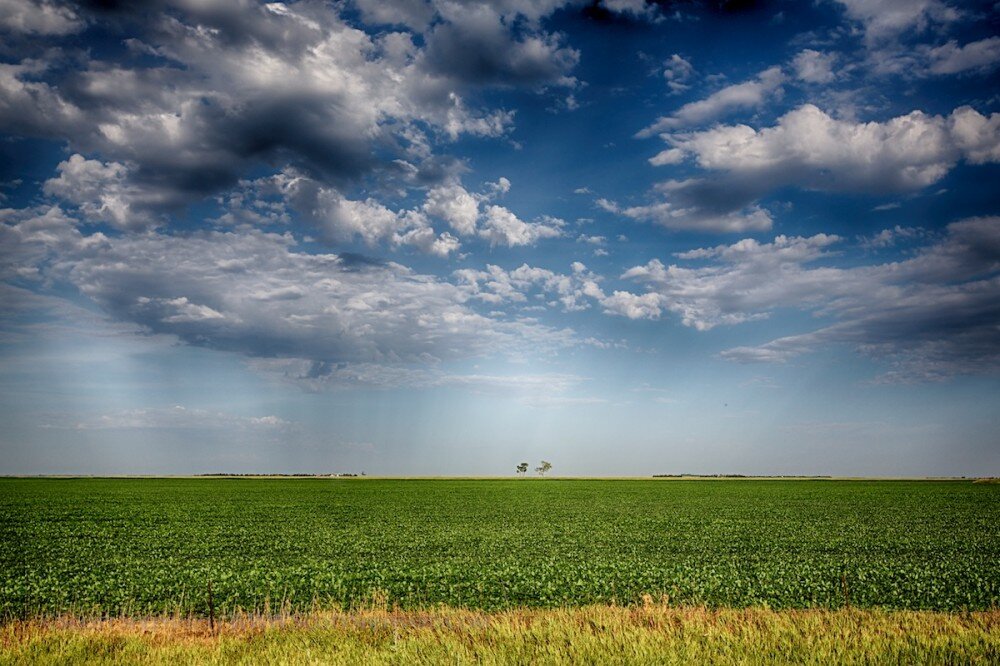 This is another HDR (high dynamic range) photo that is actually a combination of two photos. I'm not sure I like the dramatic "rays" that seem to be streaming to the ground from the clouds because I didn't see them when I took the photo. And they look a little unreal.But they are real. The HDR process only enhances and demonstrates what the camera "sees." As I was looking at this photo, wondering whether I should post it, it occurred to me that light is to a good camera what the high pitched dog whistle is to a dog: the camera and the dog perceive things much differently than humans do. And though cameras are tuned by humans to show us what humans normally see in terms of color, brightness and contrast, software processes allow us to see an alternate reality. In this case it is an HDR photo that shows us what shadows under clouds look like.On a side note, I took this photo where I did to pay homage to my mother- and father-in-law. Years ago they had a painting hanging over their couch that was a winter scene showing a prairie that was table flat and that stretched out to infinity. My mother-in-law said the picture reminded her of home, which was Hand County, South Dakota.Though it isn't winter yet in this scene, the landscape is certainly table flat.
This is another HDR (high dynamic range) photo that is actually a combination of two photos. I'm not sure I like the dramatic "rays" that seem to be streaming to the ground from the clouds because I didn't see them when I took the photo. And they look a little unreal.But they are real. The HDR process only enhances and demonstrates what the camera "sees." As I was looking at this photo, wondering whether I should post it, it occurred to me that light is to a good camera what the high pitched dog whistle is to a dog: the camera and the dog perceive things much differently than humans do. And though cameras are tuned by humans to show us what humans normally see in terms of color, brightness and contrast, software processes allow us to see an alternate reality. In this case it is an HDR photo that shows us what shadows under clouds look like.On a side note, I took this photo where I did to pay homage to my mother- and father-in-law. Years ago they had a painting hanging over their couch that was a winter scene showing a prairie that was table flat and that stretched out to infinity. My mother-in-law said the picture reminded her of home, which was Hand County, South Dakota.Though it isn't winter yet in this scene, the landscape is certainly table flat.
08-05-12 Window Peeking
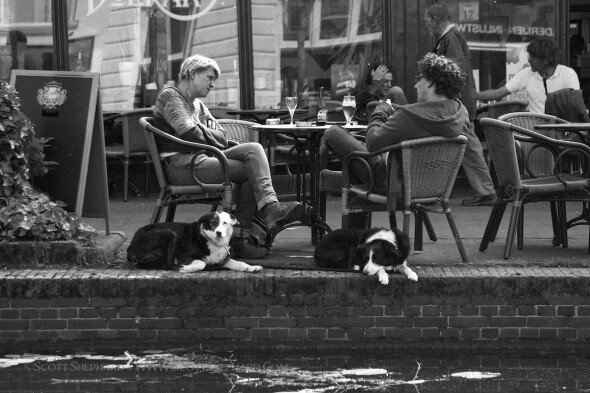 In my quest for something other than landscape and macro photos for this blog, I have gone "dumpster diving," which is my term for going back to old photos that people more organized than I would have gotten rid of a long time ago.This picture, taken in Delft, Netherlands, is certainly not art. But it is a narrative. Because of that, I converted it to black and white, in part because it was the two dogs that caught my eye in this scene and they were both black and white to begin with.And why is it a "narrative." Well, I think it tells a story, though, like so many other photos, it has many different stories to tell if you give it a chance. Is it about how life in Delft in different than life in your home town? Is is about the couple? What is the young man saying that is causing the woman to look the way she looks? What about the man in the background with his hand to his head?And, of course, what about the dog looking my way?What I like about candid photography is that though I am really "in" the photo because of how I frame the scene, I am also a kind of a voyeur. And so are you. As a photographer, I am saying "Look into this window and feast your eyes."
In my quest for something other than landscape and macro photos for this blog, I have gone "dumpster diving," which is my term for going back to old photos that people more organized than I would have gotten rid of a long time ago.This picture, taken in Delft, Netherlands, is certainly not art. But it is a narrative. Because of that, I converted it to black and white, in part because it was the two dogs that caught my eye in this scene and they were both black and white to begin with.And why is it a "narrative." Well, I think it tells a story, though, like so many other photos, it has many different stories to tell if you give it a chance. Is it about how life in Delft in different than life in your home town? Is is about the couple? What is the young man saying that is causing the woman to look the way she looks? What about the man in the background with his hand to his head?And, of course, what about the dog looking my way?What I like about candid photography is that though I am really "in" the photo because of how I frame the scene, I am also a kind of a voyeur. And so are you. As a photographer, I am saying "Look into this window and feast your eyes."

